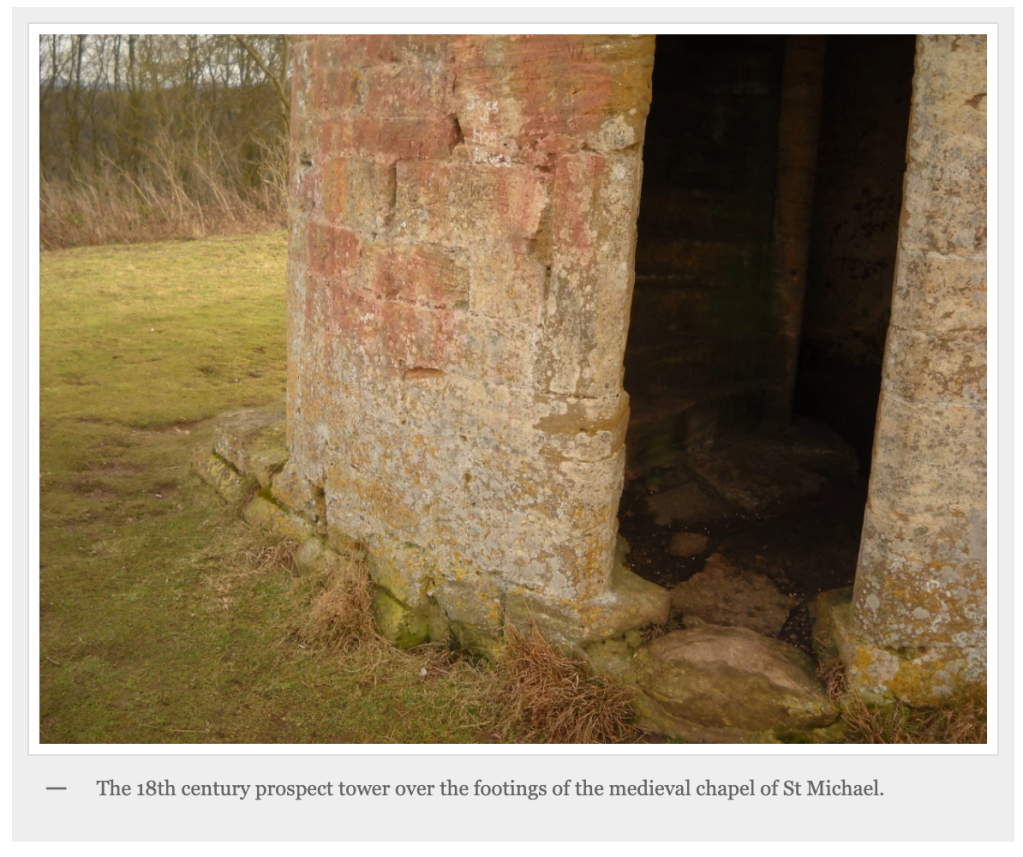St Michaels Hill, Montacute
The stile and notice board showing an artist’s reconstruction of the Norman castle.

I reached the top of the hill, caught my breath and apologised. I hoped that they would forgive me for arriving so late and began to talk about this special place (Usually I bring pictures, I hope this blog makes up for that a bit)
The National Trust does own some spectacular hill tops and St Michaels on the Montacute Estate is a good example. The rain cleared while we were on the summit and the views across the Somerset countryside stretched gin clear for many miles in all directions.
The 18th century prospect tower built on the flat summit of St Michael’s Hill with its views out across the Somerset landscape.

Such a vantage point must have been valued in pre-Saxon times. The Saxons found a stone cross here which they venerated as a sacred Christian relic. The Normans took the place over in 1066 and decided to build a castle here and renamed the place the steep hill (Mons Acutus). The locals were angered by this lack of respect for a holy place and attacked the new castle …but their revolt failed.
The castle was not needed for long and in 1102 a monastery was founded at the bottom of the hill, the castle was cleared and a chapel built there. It was dedicated to St Michael the archangel, leader of the heavenly host, often the saint chosen for hill top locations.. Glastonbury Tor and St Michael’s Mount in Cornwall are other examples.
The 18th century prospect tower over the footings of the medieval chapel of St Michael.

The chapel stayed there until at least 1630.. even after the priory was put out of action in 1538, during Henry VIII’s ‘Dissolution’ of the monasteries.
About 1600, the Phelip’s family (who had purchased the monastic land from the crown) built the magnificent Montacute House out of the local golden-coloured Ham stone. It was built next to the village reusing much of the stone from the ruined monastery which in its day had taken materials from the castle.
By 1760, the hill was valued as an ‘eye-catcher’ for the house.. something to look up to. A spiral track lined with trees was designed to enable easy access to the top of the hill. Here they built a prospect tower and above its door, in Ancient Greek, they inscribed the word ‘periscope’. You can still climb up the tower’s stone spiral stair to the top.
The view from the lower bailey showing the rampart and the steep slope up to the summit and the 1760 prospect tower.

We walked down the hill to the middle castle ward and looked at the moss covered wall hidden by trees marking the terrace edge. We considered the massive amount of work needed to re-profile the hill, probably using conscripted Saxon labour.
Today’s conservation management of the hill is a battle with trees and scrub. In the 1940s the hill was grass covered and grazed by sheep but grazing stopped and it became overgrown with scrub woodland. George the ranger has worked hard with his team of volunteers, it looks good this year but needs a few cattle up there in the Spring to keep the regrowth down.

St Michael’s Hill in the 1940s when the hill was grass covered and the ‘hat-like’ shape of the hill was clear. The timber Norman keep once stood on the summit the perimeter defended by palisades. The stables, garrison and store buildings would have been on the lower terrace. Montacute House is middle left in the photo. The priory site is centre right in the field right of the parish church.
There has been very little archaeological excavation to help understand the massive earthworks created over 900 years ago, but in 2010 I carried out a watching brief when a new water trough was installed on the hill. I noticed that burrowing animals had dug into the broad lower terrace. It’s always worth looking in mole hills and rabbit burrows. In the disturbed soil was some of the rubbish the Norman garrison had left behind.. fragments of cooking pots and splinters of animal bone, left-overs from their meals.

Norman pottery uncovered by rabbits burrowing into St Michael’s Hill
Such scraps enable you to touch the past and to realise that there is still so much more that can be learned about this place.
Martin Papworth
